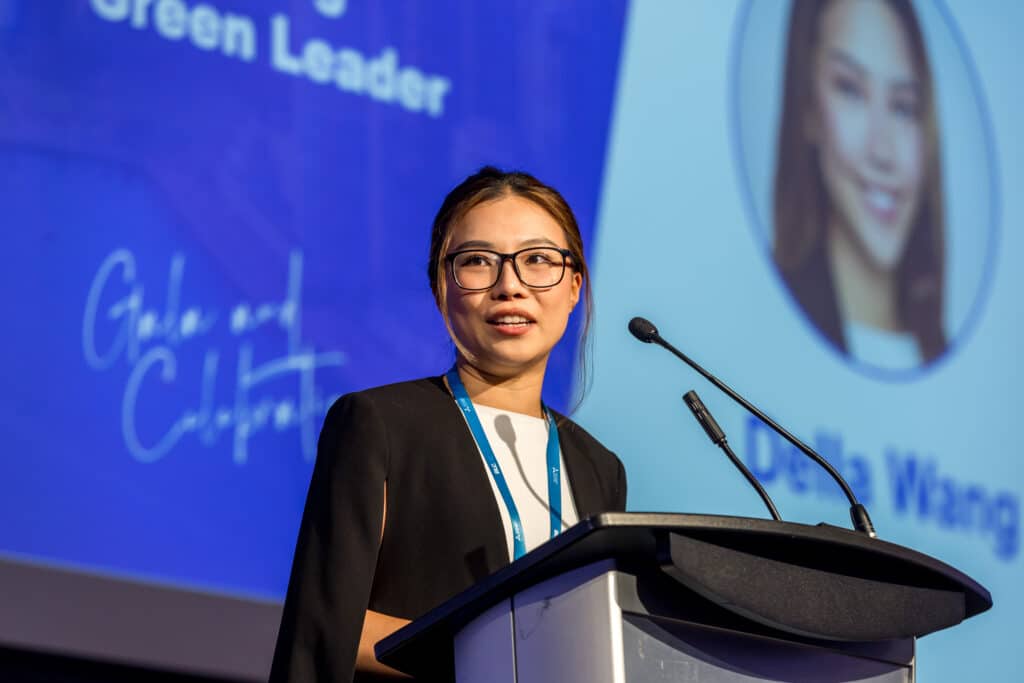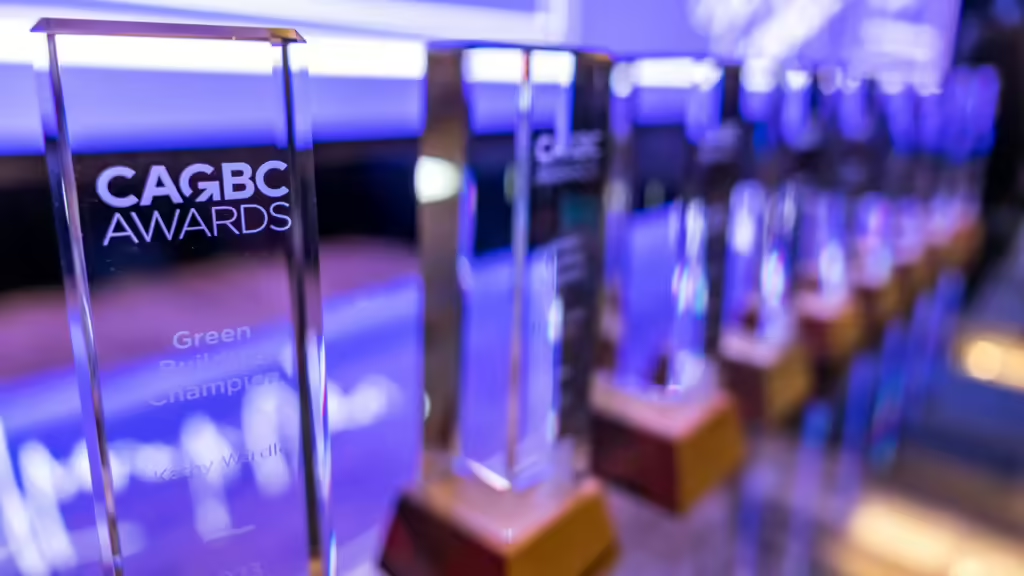Investing sustainably in shifting markets, with Della Wang
CAGBC Staff on September 10, 2025
- Theme
- Member Profiles
A rising force in sustainable asset management, Della Wang is leading Fengate’s Responsible Investment strategy with a rare blend of financial acumen and environmental insight. As Director of Responsible Investment, she’s led the development of Fengate’s sustainable design standards, launched a firm-wide due diligence program including standardized physical climate risk assessment, and produced Fengate’s first Sustainability Report. She’s the winner of the 2025 CAGBC Award for an Emerging Green Leader. In this interview, she discusses the green investment landscape and risk assessment practices in the Canadian real estate sector.
There’s a lot of talk on greenhushing and corporations are backing away from their sustainability commitments. Do you think this is a trend?
While recent headlines indicate that certain organizations are quietly retreating from ESG reporting and sustainability commitments, I believe this shift is not simply due to a diminished prioritization of sustainability within corporate agendas. Rather, it reflects the rapid and widespread adoption of ESG practices in the late 2010s, when many organizations were urged or incentivized to set ambitious targets sometimes at the cost of thoughtful and practical integration.
Currently, as ESG receives less public attention, I believe that companies have a valuable opportunity to recalibrate. Organizations can now align their sustainability objectives more strategically with core business functions and investment strategies, tackling initiatives that are both practical and impactful.

Although it may feel like progress has slowed, this moment feels inherently different to me. A large part of the industry no longer needs convincing that climate risk is real or that sustainability and resilience go hand in hand. The realities of climate change present challenges for decades to come. Therefore, integrated climate management strategies are not simply a temporary trend but a long-term necessity as fiduciaries. We are entering a new phase where organizations can build sustainability into their business in meaningful and lasting ways, recognizing that environmental responsibility can be essential to long-term financial success.
How important are ESG considerations in your investment strategy? How would you characterize demand for ESG-compliant investments amongst your clients?
Despite headlines of pullback, in my experience investors are increasingly becoming more sophisticated regarding their ESG requirements. This trend is evident not only among traditional European leaders in sustainable investing, but increasingly among North American investors as well. The emphasis from Limited Partners is shifting from ESG as a screening tool during diligence to being a driver of value creation.
They are asking for case studies of how ESG has played a role in investment or operating decisions, and what managers are doing to ensure assets’ readiness for a transition into a low-carbon economy. The emphasis has shifted beyond immediate investment horizons, with a growing expectation for investment managers to demonstrate robust scenario planning and resilience through to 2050 and beyond. As a result of this, I have observed industry standards in the real estate sector rising, where sustainable design and operating practices are not a differentiator but increasingly becoming a standard for managers. Also, with the rising adoption in green building certifications and benchmarking tools, investors are able to more efficiently compare and contrast managers’ performance in these areas.
How do you manage to integrate these throughout an investment lifecycle? What do you consider fundamental criteria in your real estate portfolio and what tools do you rely on to meet them?
For Fengate, integrating ESG considerations throughout the investment lifecycle requires three key ingredients: the right tools, the right people at the table, and the right timing. This makes it both an art and a science. It begins with due diligence where we have established a standard set of questions and risk rating criteria that helps guide the investment team to appropriately assess the risks and opportunities on a 1–10-point scale. This allows for comparability between investment opportunities that may vary in type, size, and location. Certain questions require further support through tools to help conduct physical climate risk scenario analysis, nature and biodiversity risk assessment, and climate transition risk assessment.
Throughout ownership, we have established ongoing monitoring and engagement with property management teams and tenants. We use data management tools such as Brightly to track real-time sustainability metrics, and have quarterly sustainability meetings to set goals, measure outcomes, and share feedback and insights. We are also working with sustainability consultants to conduct a series of decarbonization studies across our portfolio to establish a long-term capital allocation program focused on achieving a Carbon Risk Real Estate Monitor (“CRREM”)-aligned decarbonization pathway for the assets we manage.
Our fundamental criteria require that each asset be prepared to manage both physical and transition climate risks, actively pursue resource efficiency and biodiversity protection, and conduct ongoing community engagement throughout its operation. To analyze physical climate risks, we rely on third-party tools that help us efficiently incorporate scenario analysis into our due diligence process. These resources streamline complex assessments and make it easier for our team to identify and address potential risks early on. Currently, we are also developing an internal framework for sustainable design principles and retrofit guidelines. This initiative will empower our team to establish clear targets at the beginning of each investment opportunity, and ensure we meet those objectives with a replicable, high-impact, yet realistic approach.
In your opinion, what are some emerging alternative real-estate investments that can support the transition to a low-carbon economy?
This is an increasingly relevant question as the real estate sector evolves to adapt to the climate-related risks we face today. We have seen a surge of interest in alternative real estate investments that directly enable the transition to a low-carbon economy. Examples include adaptive reuse of existing buildings, which extends the life of built assets and reduces waste, and modular construction or mass timber, both of which reduce embodied carbon and enhance efficiency.
Innovative mechanical systems such as wastewater energy transfer, deep-lake cooling, and geothermal solutions amongst more common electric heat pump systems are also drawing attention for their potential to reduce operational emissions. Beyond that, sustainable urban agriculture, green roofs, and mixed-use developments that integrate nature-based solutions are gaining traction as impactful ways to support both environmental and social outcomes. Transit-oriented developments with low-carbon designs offer the dual advantage of lowering emissions and promoting vibrant, connected neighbourhoods. Fengate has a few geothermal projects under development and is exploring various innovative sustainable design solutions where we have seen evidence of successful implementation here in North America.
For Fengate, as the investment landscape shifts, it’s essential to remain agile, seek out partnerships with forward-thinking developers, and look to other European and Asian markets for inspiration. With continued innovation and collaboration, these solutions can move from experimental to mainstream, empowering more organizations to adopt climate-forward technologies confidently.
Any piece of advice for fellow Emerging Green Leaders?
If I were to offer a guiding thought to fellow Emerging Green Leaders, it would be this: embrace curiosity and challenge the norm. The path toward a sustainable future requires not only technical expertise, but also the boldness to think beyond the status quo.
My own journey in sustainability has been unconventional, coming from an education background in finance and accounting, and I have found it invaluable to consistently seek knowledge from colleagues and to appreciate insights from a diverse range of disciplines. On the days where progress feels slow, especially against a challenging macro-economic backdrop, it is important to reconnect with the underlying motivation that drew you to this field. The passion and personal motivation beyond it all are what helps me pull through the more challenging days.

Lastly, remember that organizational culture and the strength of collaborative teams are critical enablers of success. Do not underestimate the impact of a cohesive, well-aligned team. That should always be the number one goal when green leaders are setting out sustainability targets – to bring everyone along on the journey.
